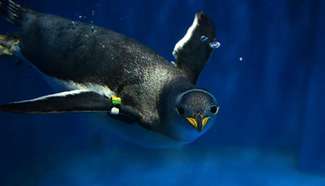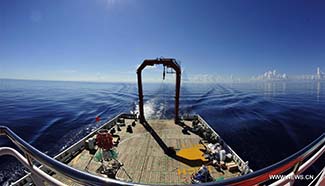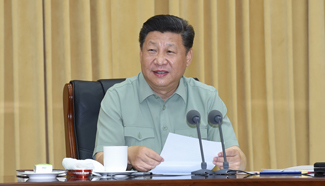BEIJING, July 28 (Xinhua) -- Having stopped in 17 cities and flown approximately 43,000 kilometers, Solar Impulse 2, the sun-powered airplane, has successfully landed in Abu Dhabi, concluding its round-the-globe journey and becoming the first aircraft to circumnavigate the globe without a drop of liquid fuel.
The aircraft began its journey by taking off from Abu Dhabi on March 9, 2015, traveled through the airspace of India, Myanmar, China, Japan and the United States and landed in the cities of Ahmedabad, Nanjing, San Francisco, New York, Seville and Cairo.
While in New York, UN Secretary-General Ban Ki-moon met with the two pilots, saying that "the plane's technologies can help halve the world's energy consumption, save natural resources and improve our quality of life."
Solar Impulse 2 is the second of its kind under the Solar Impulse project, which is privately financed by Swiss engineer Andre Borschberg and psychiatrist/aeronaut Bertrand Piccard.
The two men behind the project also took turns to pilot the aircraft during its world journey.
Solar Impulse 1, the prototype, was designed to remain airborne up to 36 hours and conducted its first test flight in December 2009.
Piccard and Borschberg completed successful solar-powered flights from Switzerland to Spain and then Morocco in 2012 with the prototype, and conducted a multi-stage flight across the United States in 2013.
Completed in 2014, Solar Impulse 2 carries more solar cells and more powerful motors, and the wingspan has also increased to 71.9 meters.
Here are some key events of Solar Impulse 2's 17-leg journey:
July 23, 2016: It left from Cairo and arrived at Al Bateen Executive Airport in Abu Dhabi, the capital of United Arab Emirates, after flying more than 40,000 km, completing an around-the-world journey.
July 11, 2016: It took off from Seville, the fourth-largest city in Spain, and landed in Cairo in 48 hours and 50 minutes, flying over the Mediterranean Sea.
June 20, 2016: It departed from New York and landed in Seville in 71 hours and 8 minutes, completing the first transatlantic solar and electric crossing.
June 11, 2016: It took off from Lehigh Valley in the U.S. state of Pennsylvania and landed in New York in 4 hours 41 minutes.
May 25, 2016: It left Dayton in the U.S. state of Ohio and arrived at Lehigh Valley in 16 hours and 49 minutes.
May 21, 2016: It departed from Tulsa in the U.S. state of Oklahoma and arrived in Dayton in 16 hours and 34 minutes.
May 12, 2016: It took off from Phoenix in the U.S. state of Arizona and landed at Tulsa International Airport in Oklahoma in 18 hours and 10 minutes.
May 2, 2016: It left San Francisco and arrived in Phoenix in 15 hours and 52 minutes.
April 21, 2016: It took off from Kalaeloa, Hawaii, and arrived at San Francisco in 62 hours and 29 minutes, completing a crossing of the Pacific Ocean.
June 28, 2015: It departed from Nagoya in Japan and arrived in Kalaeloa in 117 hours and 52 minutes, breaking the world record for distance and duration for solar aviation, as well as the world record for the longest solo flight.
May 30, 2015: It took off from Nanjing in China and made an unintended stop in Nagoya because of bad weather after taking off from Nanjing on May 30. The flight time was 44 hours 9 minutes.
April 20, 2015: It left Chongqing in China and landed in Nanjing in 17 hours 22 minutes, after a 3-week standstill in Chongqing.
March 29, 2015: It took off from Mandalay in Myanmar and landed in Chongqing in 20 hours 29 minutes after a challenging flight over the Burmese mountains, making it the first solar airplane that landed in China.
March 18, 2015: It departed from Varanasi in India and landed in Mandalay. During the journey, Piccard, who was piloting the plane, beat Solar Impulse 2's own speed record by flying at 216 km/h.
March 18, 2015: It left Ahmedabad, India, after a suspenseful wait because of customs issues and landed in Varanasi in 13 hours 15 minutes.
March 10, 2015: It took off from Oman and landed in Ahmedabad in 15 hours 20 minutes, making it the first solar aircraft that landed in Asia and also completing a record-breaking flight in terms of distance flown with a solar plane.
March 9, 2015: Solar Impulse 2 took off from Abu Dhabi and landed in Oman, the first leg of its around-the-world journey, in 13 hours and 1 minute.










